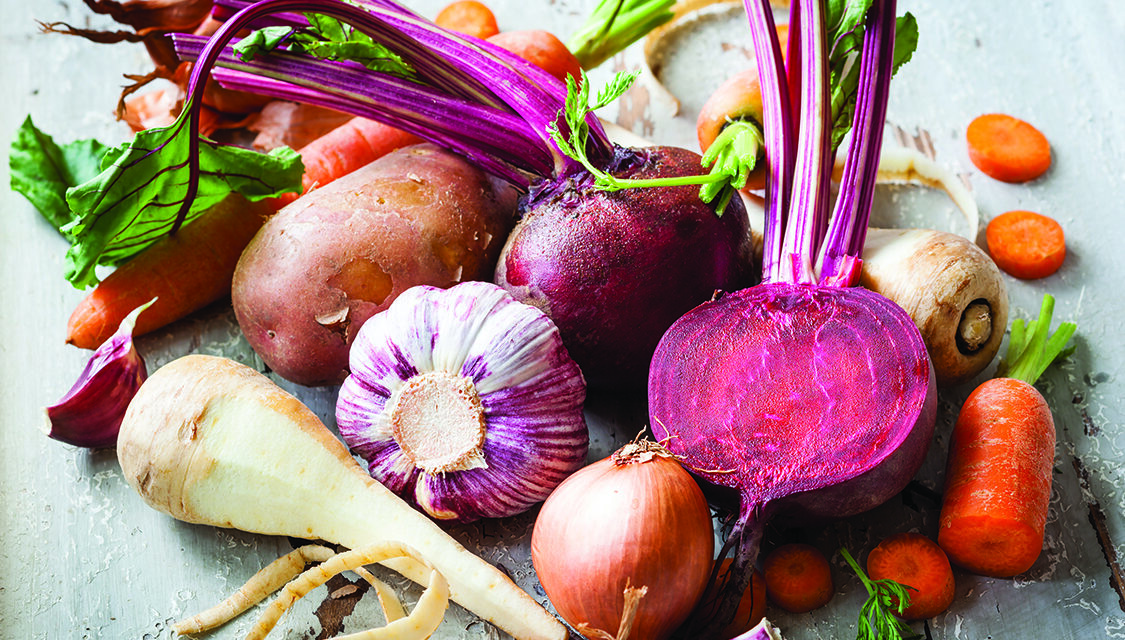
Beets pack a good amount of fiber, folate and manganese into each serving. They’re also high in nitrates, which are beneficial plant compounds that can help dilate your blood vessels, potentially lowering blood pressure and improving heart health.
Every vegetable crop needs its roots, but when the roots are the vegetable that’s consumed, it’s all the more important.
Most root vegetables are good sources of vitamins A and C, which boost the immune system; fiber, which aids digestion; antioxidants, which scavenges free radicals from the body and may reduce the risk of heart disease and some cancers and manganese, which helps bone, tissue and blood health.
“Because root vegetables like beets, carrots, sweet potatoes, yams, parsnips, turnips, radishes and onions grow underground, they absorb a tremendous amount of nutrients from the soil,” says Katie Rankell, a registered dietitian and program director of the University of California’s Health Weight Management Program. “That makes them dietary powerhouses.”
While carrots and potatoes may get more attention than their underground-growing brethren, there are many root vegetables to choose from for health benefits and hearty eating.
Due to sweet potato’s vitamin A content, studies suggest it may also improve immune function, protect against vision loss and support skin health.
Turnips and rutabaga have an impressive nutrient profile, being a great source of vitamin C, fiber, manganese and potassium.
“Turnips are a great cool-weather root crop and an excellent addition to spring and fall meals. They’re easy and quick to grow, offer variety and good taste, plus you can eat the entire plant,” said Erica Smith Montgomery County Master Gardener in the Maryland Grows Blog.
Adding turnips to your diet can help boost your immunity, with one study noting that getting enough of this vitamin could help reduce symptoms and shorten the severity of respiratory infections, such as the common cold.
Ginger is loaded with antioxidants, including gingerol, a compound associated with numerous health benefits. It may also decrease pain and inflammation, with other research showing that ginger extract could help relieve menstrual pain and reduce symptoms in people with osteoarthritis.
Beets pack a good amount of fiber, folate and manganese into each serving.
They’re also high in nitrates, which are beneficial plant compounds that can help dilate your blood vessels, potentially lowering blood pressure and improving heart health.
Studies also show that eating beets may improve exercise performance and increase blood flow to your brain.
Additionally, studies have found that beet extract may have anticancer properties and may slow the growth and spread of cancer cells.
“Beets generally take 50 to 70 days to reach maturity, so planting more now will yield another crop by the last official day of summer,” said Associated Press garden writer Jennifer Domiano. “As a bonus, late-season beets tend to grow sweeter and more vibrantly hued than spring-planted ones, benefitting from the season’s gradually dropping temperatures.”
Radishes may be small, but they manage to pack a punch when it comes to nutrition.
They’re low in carbs and calories yet contain a good amount of fiber and vitamin C.
Radishes also have antifungal properties and have been effective against several types of fungus in test-tube and animal studies.
Along with vitamin C, potassium and manganese, fennel also contains the compound anethole, which gives fennel its distinct flavor, aroma and a wide array of health benefits.
Fennel can be enjoyed fresh, roasted or sautéed, as well as mixed into salads, soups, sauces and pasta dishes.
Perhaps even lesser known, celeriac, or celery root, contains a hearty dose of vitamins C and K and phosphorus.
Celeriac works well in salads or it can also be boiled, roasted, baked or mashed and used in place of potatoes in nearly any recipe.
Turmeric contains a compound called curcumin, which has been shown to prevent blood clot formation, lower cholesterol levels and reduce markers of inflammation in both test-tube and animal studies.
Research in humans also suggests that curcumin may alleviate joint pain, stabilize blood sugar levels and decrease symptoms of depression.
Pairing turmeric with black pepper helps boost the absorption of curcumin in your gut.
Grocery stores keep a good supply of many root vegetables but there’s also still time in the growing season for gardeners to grow their own.
“Second crops of chards (50 to 75 days), peas (60) and even beans (45 to 70) can also be planted in late summer. Check the dates to maturity on their seed packets to determine if they’ll mature before frost hits your region. If not, plant or start seeds indoors earlier next year. While you’re at it, try crispy choi, a crisp, fast-growing Chinese green that matures in just 45 days. Harvest before side shoots develop,” said Domiano.
“Gai lohn, sometimes called Chinese kale or Chinese broccoli, is easier to grow than standard broccoli. Its stems and yellow or white flower buds can be harvested as they grow, generally in as little as 45 days.
“And if you’re really short on time, consider Mizuna, a Japanese mustard green that makes a wonderful addition to salads. You’ll be able to start harvesting the plant’s outer leaves in as little as three weeks and the whole plant in just 35 days.
In relatively short order, you can grow your own root crops that offer health benefits toward a longer life.




